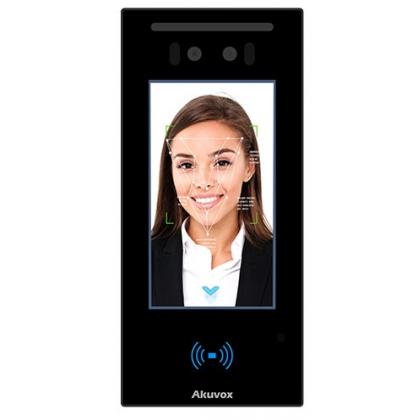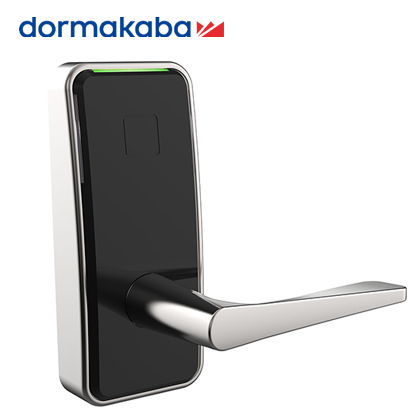What is RFID Access Control?
RFID is a wireless signal transmission technology frequently used for user credentials and keyless entry in access control and door intercoms.
What is RFID Access Control?
Radio Frequency Identification (RFID) is a wireless signal transmission technology frequently used in access control and door entry systems, which allows only authorised/registered users to enter secure spaces. RFID uses radio waves to read and capture data stored on tags (such as cards or keyfobs) to provide unique information for the subject or individual.
How does RFID work?
RFID systems are made up of 3 main components:
- RFID tags/smart labels
- RFID reader
- Antenna
The RFID tags/smart labels wirelessly transmit data to the RFID reader, the reader then converts the radio waves into a more usable form of data. Information collected from the tags can be cross-referenced with a database of registered user accounts to allow or prevent access through electronically-locked doors, gates, barriers etc.
What is an RFID tag?
 An RFID tag consists of an integrated circuit and antenna. The tag has a protective material that both holds the pieces together and shields them from environmental factors. RFID tags come in various shapes, sizes & formats - such as keyfobs and ID cards - and can be active or passive.
An RFID tag consists of an integrated circuit and antenna. The tag has a protective material that both holds the pieces together and shields them from environmental factors. RFID tags come in various shapes, sizes & formats - such as keyfobs and ID cards - and can be active or passive.
What are Passive tags?
Passive tags are the most widely used this is mostly down to the fact they are smaller and the least expensive to use. Passive tags have to be powered up by an RFID reader before they can transmit data.
What are Active tags?
Active tags have their own power supply (ie. a battery) which means they can transmit data at all time.
What are Smart labels?
Smart labels incorporate both RFID and barcode technologies, they can be encoded and printed on-demand. Whereas RFID tag programming is more time consuming and more advanced.
What is secure RFID?
Access Control units with secure RFID can read a cards PAC ID (if the card or fob supports it) or Serial Number, whereas standard RFID only reads the cards Serial number. You can choose in the allowed card types which the module will read - PAC or Serial Number. Only one can be selected, otherwise it always reads the PAC ID.
What can RFID technology be used for?
As well as Access Control RFID technology can also be used for:
- Inventory management/tracking
- Personnel and Asset tracking
- ID badges – staff, patients and students tracking
- Race timing
- Automated toll systems
- Counterfeit prevention

What are the benefits of RFID in access control?
- Keyless entry
- Contactless (Covid-secure)
- RFID works in extreme temperatures which are great for access control that is usually outside in sunshine, rain, snow and varied temperature conditions.
- Having RFID access control can help deter theft as it is harder to break into than the traditional lock and key.
- RFID access control can track who comes in and out of the building which improves safety of not only belongings but people in the building.
- Using RFID you can limit access to restricted areas based on roles to ensure no entry is gained to out of bounds areas.
- RFID access control complies with government-regulated security protocols
- RFID has an increased reading distance.
- You can update RFID card data without needing to issue a new ID.
- You can read multiple RFID IDs at once
What are the disadvantages of RFID in access control?
- Chance that any person equipped with an RFID reader could access the information embedded on each card, which cannot discern between a friendly reader and a hostile one.
- RFID cards are prone to electromagnetic interference, which can come from other RFID cards or any other magnetized device.
- Meaning they can easily be jammed or lose their ability to transmit information.
- RFID cards are also easily cloned if their information is stolen.
Find out more...
What other keyless/contactless technologies are available?
- Bluetooth/BLE - Bluetooth door entry utilises each individual user's smart phone with installed app for wireless transmission of access credentials and a Bluetooth Access proximity reader to receive the signal. When the device is near to the Access reader, the application communicates with the reader and exchanges the security key to authenticate and opens the lock to allow entry.
- NFC - Access and Intercom system manufacturers are now incorporating NFC reader technology into access control and door intercom devices as a standard option as the trend for secure, convenient, wireless door unlocking becomes a growing requirement for residential and commercial users.
- Face recognition - A face recognition-based system will use access control end-points featuring integrated, high resolution cameras which will provide a live face scan of the individual at the door or gate.To authenticate each individual's identity and, therefore, allow access, the system will accurately match the unique face 'co-ordinates' to those stored on the database.
- QR code scanning - In the case of access control via QR codes, typically the entry system will include PC software or a smart phone App which can quickly and easily generate a unique QR code which can be set to allow access for a limited time period, specific days of the week, limited number of uses and entry limited to specific areas, floors or zones of the building.
Need help choosing the right Door Intercom?
CIE is one of the UK's leading distributors of professional access control and door intercom products from leading brands 2N and Akuvox.
Our professional system design team provide a unique system architecture service for installers and integrators to help you deliver the best in door entry and access control technology.
If you would like to discuss your next access control system or would like more information on our full range of security products, please call our team today on T. 0115 9770075 or email us now.














